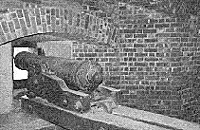 The first structure built where the river joins Lake Ontario near Youngstown, New York was Fort Conti, completed by La Salle in 1679. This crude post soon succumbed to fire, and was replaced by another, Fort Denonville, which likewise failed to achieve permanence.
The first structure built where the river joins Lake Ontario near Youngstown, New York was Fort Conti, completed by La Salle in 1679. This crude post soon succumbed to fire, and was replaced by another, Fort Denonville, which likewise failed to achieve permanence.
France eventually overcame isolation and Iroquois resistance, building a three-story stone "machicolated house" in 1726 and 1727. It was undoubtedly a fort, but one designed with a view to misleading the Indians into thinking that it was primarily a trading post and not a military work. An outer palisade protected the building, then was replaced in the French and Indian War with an earthen, classically European rampart that stretched across the peninsula between the waterways. The British took the fort in 1759 in a textbook Vauban-style siege. In the coming years, and ensuing conflicts, as the British and Americans took turns occupying Fort Niagara, the post evolved, with the inland defenses still following the lines laid out by the French.
These were finally faced with brick in 1863, as tensions between the United States and Britain threatened still more war along the Niagara frontier. In a pattern that would be replicated on the other side of the border, Fort Niagara subsequently fell into disrepair. A "New Fort Niagara" outside the walls served the US Army into the 20th century, but "Old Fort Niagara" was allowed to slip into ruins. During the 1920's, the Army began restoring the old fort, a task finished in 1934. After World War II, the Army departed, leaving a small Coast Guard station on the river as a last remnant of the site's centuries-long military presence, and the entire post became a New York state park.
 Interior of a Brick Casemate at Fort Niagara
Interior of a Brick Casemate at Fort Niagara
Today, the old fort is one of the largest and best-preserved forts on the continent. The early 18th century machicolated house, better known as the French Castle, was the first building to be restored, and is, without a doubt, the centerpiece of Fort Niagara. It does not resemble a castle so much as a mansion with commercial and military overtones that are more apparent on the interior than from outside. There are few other structures dating from the French tenure. Most notable is the Gate of Five Nations, the main entrance to the fort, which is actually a stone redoubt guarding a drawbridge. Just as the Castle was a ruse to fool the Indians into thinking that the fort was not really a fort, the gate was named to appeal to the Iroquois confederation.
Two of the more interesting buildings are the North and South Redoubts, inside the bastions on the Niagara River and Lake Ontario respectively, built by American masons for the British in 1770. These squat gray towers offer good fields of fire for artillery and infantry, and are topped by Chinese-style roofs that might seem incongruous today, but were popular at the time.
For all of its old and varied architecture, one of the most striking attributes of Fort Niagara is its empty space. The fort is huge, having been expanded by the French to eight times its original size in the 1750's.
Niagara Frontier Touring the Restored Forts
-
Niagara Frontier: Introduction
Niagara Frontier: Fort Niagara
Niagara Frontier: Fort Erie
Niagara Frontier: Fort George
Niagara Frontier: Fort Mississauga
Niagara Frontier: Battlefield of Queenston Heights
Niagara Frontier: Getting There
Back to Cry Havoc #18 Table of Contents
Back to Cry Havoc List of Issues
Back to MagWeb Master Magazine List
© Copyright 1996 by David W. Tschanz.
This article appears in MagWeb (Magazine Web) on the Internet World Wide Web. Other military history articles and gaming articles are available at http://www.magweb.com